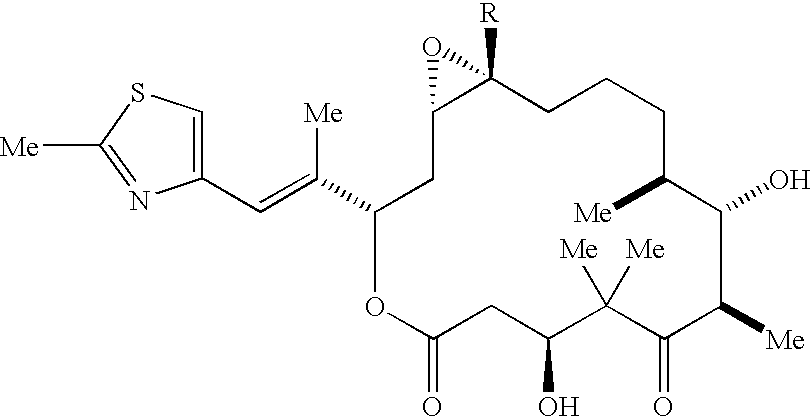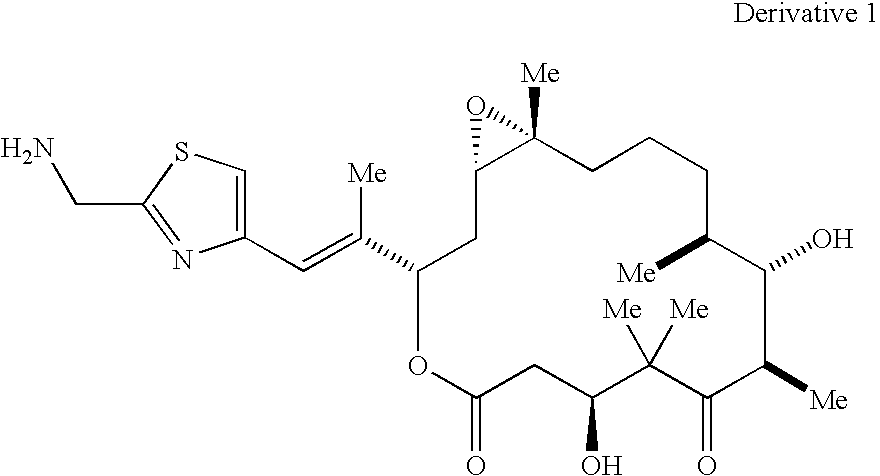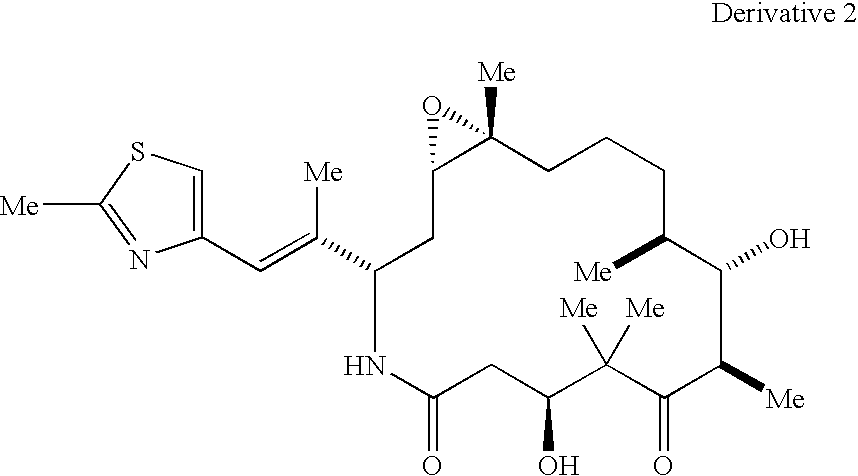Methods for the preparation, isolation and purification of epothilone B, and x-ray crystal structures of epothilone B
a technology of epothilone and x-ray crystal structure, which is applied in the field of preparation, isolation and purification of epothilone b, can solve the problems of difficult recovery of pure epothilone b, low ratio of epothilone b to epothilone a in fermentation, and only a small quantity of epothilone, so as to improve the quality of epothilone extract, improve the quality of epo
- Summary
- Abstract
- Description
- Claims
- Application Information
AI Technical Summary
Benefits of technology
Problems solved by technology
Method used
Image
Examples
example 1
Preparation of the Strain SC16408 by Means of Mutation and Selection, and Preparation of Cell Banks
[0093] Strain SC16408 was derived from the nitrosoguanidine (NTG) treatment of strain So ce90B2 (SC16224), followed by random selection. Thus, SC16224 was suspended in 10 mM Tris-HCl buffer and subjected to 1 mg / mL NTG for 60 minutes at pH 8.2. After treatment with NTG, colony cell lines were obtained by colony selection and tested for epothilone B productivity, and B / A ratio. Isolated colonies were transferred to flasks and cultured for 8-14 days, followed by transfers every 3-4 days in the growth medium (medium E):
[0094] Growth Medium E for shake flasks:
18 Ingredient g / L Powdered Skim Milk 4 Toasted Nutrisoy Flour 4 Tastone-154 2 Maltrin-M180 10 CaCl.sub.2.2H.sub.2O 1 MgSO.sub.4.7H.sub.2O 1 EDTA, FeIII, Na salt 0.008 HEPES 12 Glycerol 4.3
[0095] The above ingredients are added to distilled water and the pH is adjusted to pH 7.2 with 10% NaOH (or KOH) before sterilization for 30 minute...
example 2
Cultivation to Produce the Epothilones by Shake Flask Fermentation
[0099] Cells from a frozen vial (1.5 mL) are inoculated into 45 mL of medium E in a 125 mL flask and grown for 4-8 days at 30.degree. C. and 160 rpm (F1 stage). Then, 5 mL of the F1 stage are transferred to a new 125 mL flask containing 45 mL medium E and grown for 3-4 days (F2 stage). F2 stage cells are then used as inoculum for epothilone B fermentations. Ten percent of inoculum (5.0 mL) is transferred into a 125 mL flask containing 45 mL production medium. The flasks are then incubated in a shaker (160 rpm) at 30.degree. C. for 2 weeks. The production medium is modified medium E, which contains 1.6% (0.8 g) XAD-16 resin. The composition of the production medium for shake flasks is shown:
[0100] Epothilone B production medium for shake flasks:
19 Ingredient g / L Powdered Skim Milk 4 Toasted Nutrisoy Flour 4 Tastone-154 2 Maltrin-M040 10 CaCl.sub.2.2H.sub.20 1 MgSO.sub.4.7H.sub.20 1 EDTA, FeIII, Na salt 0.008 HEPES 12 G...
example 3
[0108]
20 Cultivation to produce the epothilones in 14 L fermentors F1 stage: a 3.0 mL aliquot from two frozen vials is inoculated into 90 mL of medium E in a 250 mL flask and grown for 4-8 days at 30.degree. C. and 160 rpm. F2 stage: 20 mL (10%) F1 stage cells are transferred to 180 mL of medium E in a 500 mL flask and incubated for 2-4 days at 30.degree. C. and 160 rpm. F3 stage: Repeat F2 stage to increase inoculum quantity. Transfer 20 mL of inoculum from F2 stage into 6-8 .times. 500 mL flasks each containing 180 mL of medium E, and incubate flasks for 2-4 days at 30.degree. C. and 160 rpm. F4 stage: Transfer 120 mL (10%) from F3 stage to 1080 mL of medium E in a 4 L aspirator bottle, then incubate for 2-4 days at 30.degree. C. and 160 rpm.
[0109] Medium E is used to build up the inoculum for a 14 L fermentor. The autoclave times for shake-flask and aspirator-bottle stages are 30 and 60 minutes, respectively. For the fermentor, the production medium is sterilized for 60 minutes a...
PUM
| Property | Measurement | Unit |
|---|---|---|
| volume | aaaaa | aaaaa |
| volume | aaaaa | aaaaa |
| pH | aaaaa | aaaaa |
Abstract
Description
Claims
Application Information
 Login to View More
Login to View More - R&D
- Intellectual Property
- Life Sciences
- Materials
- Tech Scout
- Unparalleled Data Quality
- Higher Quality Content
- 60% Fewer Hallucinations
Browse by: Latest US Patents, China's latest patents, Technical Efficacy Thesaurus, Application Domain, Technology Topic, Popular Technical Reports.
© 2025 PatSnap. All rights reserved.Legal|Privacy policy|Modern Slavery Act Transparency Statement|Sitemap|About US| Contact US: help@patsnap.com



